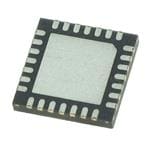An air handling unit ( AHU ) conditions and circulates air for the purpose of maintaining suitable indoor air quality for people and equipment. “Two-stage” refers to simple binary (ON/OFF) heating or cooling in the form of resistive electric elements or direct expansion (DX) cooling with a closed-system refrigerant. An AHU controller regulates all the different aspects of the AHU system, with the goal of reducing energy expenses while maintaining a safe and comfortable living or working environment. The main functions of an AHU include: heating/cooling the air to a desired temperature, mixing and filtering air to ensure proper air quality, providing enough air pressure for adequate circulation, dehumidification, and sometimes humidification (not to be discussed here).
The AHU’s processor responds to input values and conditions by turning on and off different devices in the HVAC system. Various electronic sensors constitute many of these inputs and can include:
- Pressure sensors and flow sensors to confirm positive fan status, verify appropriate static pressure levels in supply ducts, and indicate when air filters must be replaced
- Carbon dioxide (CO2) and/or air quality sensors to ensure a proper mixture of inside and outside (fresh) air
- Temperature and humidity sensors to help determine how much heating, cooling, and dehumidifying is needed
- Hall effect sensors to monitor fan motor run status
Major subsystems include:
- Sensing and monitoring (see above)
- An MCU or processor to implement control loops
- Motor drivers and relays to provide switching control to drive the compression and/or blower motors. These also isolate control electronics from power circuits to prevent damage from potential cross-overs between the circuits, shared grounds, over-voltages, and short circuits.
- Connectivity: USB, RS-232, ZigBee, etc. for remote monitoring and control loop adjustments or overrides





